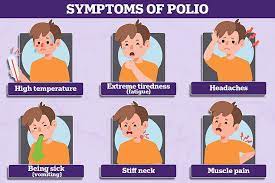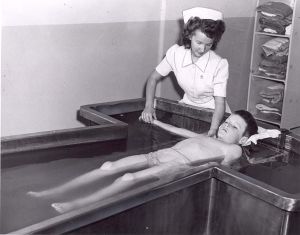Poliomyelitis
Original Editor -Chrysolite Jyothi Kommu
Top Contributors - Chrysolite Jyothi Kommu, Nikhil Benhur Abburi, Momina Khalid and Simisola Ajeyalemi
Polio[edit | edit source]
Poliomyelitis or Polio is a virus infection that replicates within the central nervous system. Poliovirus is a nonenveloped, acid-resistant virus. The protein capsid of the virus can endure to the low pH of the stomach[1]. This allows to infection in the small intestine. The poliovirus multiplies and affects the spinal cord's motor neurons, anterior horn cells ,and train stem ,leading to temporary or permanent paralysis of the muscles that they activate[2].The virus affects children under 5 years of age[3]
Mode of transmission- The virus replicates in the gut and spreads mostly from person to person by the fecal-oral route or, less commonly, by a shared vehicle (such as contaminated food or drink). [1]
Early years of Poliovirus[edit | edit source]
The poliovirus has affected mankind for thousands of years. It was first depicted in 1580 B.C. when an individual was diagnosed with foot drop deformity preventing dorsiflexion of the foot. This is the most commonly visible sign of poliomyelitis.
In 1789, an English physician first described the condition as "mostly attack children of five years or younger, gradually affecting the lower extremities."
In the latter part of the 19th century, following multiple outbreaks of the poliovirus, researchers conducted investigations that revealed its person-to-person transmission. Subsequently, they identified the viral origin of the disease.[1]
Epidemiology of poliovirus[edit | edit source]
Polio is caused with a virus of three types[2][5]
- Poliovirus Type-1-Brunhilde (PV1),
- Type-2-Lanchi (PV2),
- Type-3-Leon (PV3).
All three serotypes are capable of causing paralytic poliomyelitis, even tough type 1 causes the majority of paralytic poliomyelitis epidemics. Immunity against one doesn't protect against the other two. All three types are Since the launch of the Global Poliomyelitis Eradication Initiative in 1988, there has been considerable progress in the spread of the virus.[6]
Prevalence[edit | edit source]
After the success of smallpox vaccination campaign efforts have been put forward to eradicate polio from the world. The Global Polio Eradication Initiative focuses on high routine immunization coverage, effective surveillance and door to door immunization campaigns to immunize the last of unvaccinated. Due to vaccination, The prevalence is so low.33 cases were identified in 2018[7][8]. Pakistan and Afghanistan are the only two remaining countries in the world in the world where polio virus is endemic[9].
Pathology[edit | edit source]
- Alimentary Stage-After gaining access to the body through the nasopharynx on the GIT, Tte virus multiplies in the epithelial cells of the intestinal mucosa.
- Viremic Stage-The virus spreads through the blood stream ,and after a sort of conflict between the virus and the antibodies, infthe virus turns victorious ,it leads to the third stage.
- Neural Stage-The virus finds its way to the anterior horn cells of the spinal cord and nerve cells in the brain stem.
Clinical features[edit | edit source]
The course of the disease is divided into four stages:
Prodromal Stage or Pre-Paralytic Stage- few hours to a few days and 1 to 3 days is the usual duration.
Signs and Symptoms
- Headache.
- Sore throat.
- Malaise.
- Slight Cough.
- Diarrhea or constipation.
- Backache.
- Joint pains.
- Pyrexia of variable duration and severity.
- Mild neck stiffness.
- Irritability.[12]
Diagnosis[edit | edit source]
Diagnosis is made on:
- Detailed medical history
- Vaccination history
- History of recent travel
- Physical examination
- Collect samples of stool, blood, urine and spinal fluid
- Magnetic Resonance Imaging (MRI)
Poliovirus is mostly detected in stool specimen.[13]
Differential Diagnosis[edit | edit source]
Polio diagnosis is typically considered in endemic areas where a child below the age of 5 years presents with acute flaccid paralysis. Conditions that should be considered in the differential diagnosis of any case of acute flaccid paralysis.[14]
Gulllian Barrie Syndrome[edit | edit source]
it is a symmetrical ascending myelopathy that occurs in later stage of life. Facial nerve Palsy is typically seen. In most cases patient make a full recovery.
Acute Transverse myelitis[edit | edit source]
acute motor and sensory loss below the level where vascular supply to cord has been interrupted.
Traumatic Paraplegia[edit | edit source]
History of trauma. Fracture can be seen on the radiograph.
Acute motor axonal Neuropathy[edit | edit source]
Both motor and sensory loss. mostly bilateral. Treatment can lead to improvement.
Myopathy[edit | edit source]
LMN lesion with no sensory loss. pattern is symmetrical and predictable. Muscle biopsy may confirm the diagnosis.
Prevention[edit | edit source]
Two types of vaccines are available that are used in the prevention of polio.
- Inactivated Poliovirus Vaccine (IPV) -Mostly given as an injection in the leg or arm.
- Oral Poliovirus Vaccine (OPV) - mostly used throughout the world.
- Maintain good hand hygiene and wash hands with soap and water
Treatment[edit | edit source]
The only practical measures which can be taken-is to stop the playing of games and other such manual work if possible. The nasopharyngeal secretions and feces or highly effective at this stage of illness. An additional booster dose may be given
Acute Stage-3 to 6 weeks from the onset of Poliomyelitis.
Signs and Symptoms
- Muscle tenderness is the most important sign seen in this stage.
- to test this press the calf muscles when child is quiet. If he cries, he has tenderness.
Treatment
- Rest-The child should not be over handled.
- Isolation
- Booster dose
- Nutrition-Diet rich in" Protein".
- Sister Kenny's Bath: This is a form of moist heat. This helps to resolve inflammation to some extent.
Massage should not be given as it may cause more damage due to which the patient may not be able to walk later on.[15][2]
- MMT.
Convalescent Stage- Duration 3 months.
Signs and Symptoms
- Spinal Type-The" lower limb muscles are more often involved". Flexion contractures of hip, knee and equines deformity of the ankle are common.
- Bulbar Type-The most important sign of Bulbar paralysis is- the '' inability to swallow" due o pharyngeal paralysis. The patient requires urgent ventilatory support for respiration and Ryle's tube for feeding to save his life as both respiratory and swallowing muscles are affected. The "early signs" of respiratory involvement includes breathing, feeling of suffocation, slight cyanosis, use of sternomastoid, and other accessory muscles of respiration.
- Spinobulbar-This type has a combination of both spinal and bulbar type.
- Postencephalic-Mental disturbance, coma, paralysis of facial muscles. Symptoms similar to meningitis like headache, vomiting, neck stiffness may occur
Treatment
- Muscle Charting.
- Positioning.
- Changing the position-Turning the patient every 2 to 4 hours and night prevents bed sores and keeps the skin dry.
Stage of Recovery-This stage extends for almost 2 years. Thus muscle in the polio patient can be strengthened to their maximum capacity up to 2 years.
Stage of Residual Paralysis- Post-Polio Syndrome[3]
Treatment
- Patient is given combination of stretching, strengthening and calliperization.
- Tailor-made calipers can prevent the deformity from aggravating.
- Tendon transfers may be done for compromising balance on that side.
- Arthrodesis
Common Problems Encountered by Polio Patients
- Muscle weakness
- Bony Changes-Most common changes are-Shortening, Osteoporosis, Deformities.
Physiotherapy Management[edit | edit source]
Acute Stage
- Correct handling technique-The child should not be lifted by one hand. While carrying the child, they should be held in front and preferably with the Hip in extension without any abduction.
- Splinting and correct positioning- Splinting-Lower limb to be immobilized to prevent further damage to the muscles
- Gentle passive movement:
Convalescent Stage
- Continuous Splintage-Above knee splint or L splint, Below knee splint, Abdominal Corset.
- Muscle Charting.
- Stretching of contractures: Principal contractures are IT band and ankle equines.
- Stimulation and facilitation technique.
Stage of recovery
Various strengthening techniques include:
- Sensory integration.
- Resisted exercises with springs and pulleys,
- Hydrotherapy and suspension therapy.
- Play therapy.
- Mat Exercises
References[edit | edit source]
Physiotherapy in Neuro-conditions,Glady Samuel Raj
- ↑ 1.0 1.1 1.2 Sci-Hub | Poliovirus. Essential Human Virology, 257–271 | 10.1016/b978-0-12-800947-5.00014-4 [Internet]. Sci-hub.se. 2016 [cited 2023 Nov 17]. Available from: https://sci-hub.se/https://doi.org/10.1016/B978-0-12-800947-5.00014-4
- ↑ 2.0 2.1 2.2 https://www.scribd.com/document/407932298/Physiotherapy-in-Neuro-conditions-Glady-Samuel-Raj-pdf
- ↑ 3.0 3.1 https://physio-pedia.com/Post-Polio_Syndrome#share
- ↑ 1. Poliovirus: Video, Anatomy, Definition & Function | Osmosis [Internet]. Osmosis. 2023 [cited 2023 Nov 17]. Available from: https://www.osmosis.org/learn/Poliovirus
- ↑ http://www.pitt.edu/~super7/25011-26001/25141-25151.pdf
- ↑ https://www.ncbi.nlm.nih.gov/pubmed/18755232/
- ↑ https://www.who.int/news-room/fact-sheets/detail/poliomyelitis
- ↑ https://www.ncbi.nlm.nih.gov/pmc/articles/PMC4212416/
- ↑ Sci-Hub | | 10.1016/S2352-4642(19)30382-7 [Internet]. Sci-hub.se. 2020 [cited 2023 Nov 17]. Available from: https://sci-hub.se/https://www.thelancet.com/journals/lanchi/article/PIIS2352-4642(19)30382-7/fulltext
- ↑ 1. Polio [Internet]. AMNH. 2014 [cited 2023 Nov 17]. Available from: https://www.amnh.org/explore/science-topics/disease-eradication/countdown-to-zero/polio
- ↑ Craig E. How long does the polio vaccine last? What are the virus’ symptoms? [Internet]. Mail Online. Daily Mail; 2022 [cited 2023 Nov 17]. Available from: https://www.dailymail.co.uk/health/article-10942141/Can-polio-vaccine-missed-child-virus-symptoms.html
- ↑ Clinic C. Polio: Virus, Causes, Symptoms, Transmission & Treatment [Internet]. Cleveland Clinic. 2022 [cited 2023 Nov 17]. Available from: https://my.clevelandclinic.org/health/diseases/15655-polio
- ↑ 13.0 13.1 CDC. What is Polio? [Internet]. Centers for Disease Control and Prevention. 2023 [cited 2023 Nov 17]. Available from: https://www.cdc.gov/polio/what-is-polio/index.htm
- ↑ Soltani J, Esmailnasab N, Roshani D, Karimi M, Amjadi MJ. Acute flaccid paralysis and its differential diagnosis in in kurdistan province, Western iran; an 11-year surveillance. Iranian journal of pediatrics [Internet]. 2014 [cited 2023 Nov 17];24(2):131–9. Available from: https://www.ncbi.nlm.nih.gov/pmc/articles/PMC4268831/
- ↑ https://www.yumpu.com/en/document/view/51611849/massage-effectiveness-for-client-with-post-polio-syndrome
![1. Poliovirus: Video, Anatomy, Definition & Function | Osmosis [Internet]. Osmosis. 2023 [cited 2023 Nov 17]. Available from: https://www.osmosis.org/learn/Poliovirus ](/images/thumb/b/bb/Poliovirus.jpg/280px-Poliovirus.jpg)
![[10]](/images/thumb/8/80/Lifecycle_of_polio.png/332px-Lifecycle_of_polio.png)









